Mosque Architecture
Mosque Architecture (1205-1765) was introduced by the Muslims for the ritual needs of their religion, Islam after the establishment of Muslim rule in Bengal. Mosque architecture was different from those of the Buddhists and Hindus. Differences were due to the different nature of participation that was required. In temples, a Brahmin priest performed the rituals before the image of a deity; he alone entered the sanctum while the rest of the devotees waited outside.
The Muslims needed a large space for congregational prayer, especially on Fridays, when all men were required to perform the prayer collectively. There was no sanctum with a sacred image, and all worshipers had to stand in rows behind the imam who led the prayer. The only indispensable architectural feature was the mihrab, the niche in the qibla wall (western in South Asia) that directed the worshippers towards the Kaba in Mecca, their holiest shrine; the orientation prescribed for ritual prayer. During the Sultanate the Friday (jami) mosque became very important as an official building because the khutba (sermon delivered before the mandatory collective prayer) gave official recognition to the ruler, and also worked as a declaration of sovereignty. It expressed piety, and was a potent visual symbol of the power, ideology, and affiliation of the sponsor.
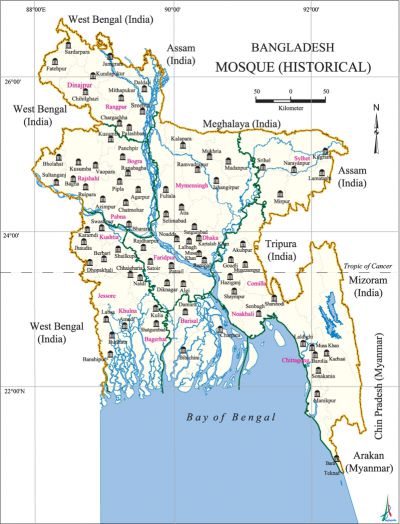
Numerous mosques were built during the five and a half centuries of Muslim rule before the British colonial period, but a few landmark monuments have been chosen to illustrate how mosque styles developed in Bengal (both the Indian state of West Bengal as well as Bangladesh). bakhtiyar khalji (1205-06), the founder of Muslim rule in Bengal, had constructed several mosques, madrasas and khanqas, all centred on the capital, lakhnauti. But unfortunately, extant monuments are few from the 13th and early 14th centuries, the only firmly dated mosque of the period being Zafar Khan Ghazi's Mosque (1298 AD), now in ruins, in Tribeni (Hughli district; West Bengal, India).
It is a large multi-domed rectangular, hypostyle building of brick with stone veneer (fig.1). Brick, easily manufactured from the abundantly available clay of the delta, has been the traditional building material of Bengal from ancient times, as seen in the ruined, but monumental mainamati and paharpur monasteries in Bangladesh (7th to12th centuries).
Stone was not available locally, and during the early part of Muslim rule it was often quarried from pre-existing temples, as seen in Zafar Khan Ghazi's mosque. Stone columns divide the interior into two aisles, each with five square bays, covered by small domes. Each one of the five bays in front has an entrance, opposite which is a mihrab in the qibla wall. Such a line-up of multiple mihrabs is absent from mosques in the central Islamic lands as only one is sufficient to signify direction. The alternative interpretation, that the mihrab symbolized the place where the Prophet stood in the first mosque of Madina, also dictates a single mihrab. This convention of multiple mihrabs axially aligned to entrances seems to have local roots, and may be traced to temple architecture, where an image niche is opposite every entrance into the sanctuary. This mihrab-entrance organisation and the rectangular shape remained popular in Bengal mosques throughout the Sultanate period. The building appears squat because the front row of arches springs directly from huge piers. The ornamentation is both in stone and terracotta, and some in a 15th century style suggestive of remodeling in later times. The inscription tablet on the central mihrab refers to Zafar Khan as a warrior and to the building as a madrasa, indicating that the mosque served a dual purpose.
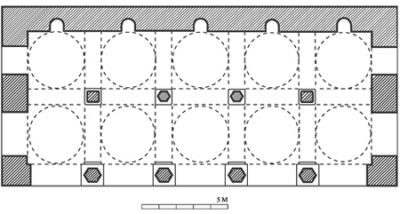
The adina mosque in hazrat pandua of Maldah district; west bengal, dated to 770 AH (1369 AD) is the only dated mosque of the 14th century which corresponds roughly to the rule of the independent Iliyas Shahi rulers (1338-1413). It is unique not only because it is the largest mosque in South Asia, but because it is the only one in Bengal with an enclosed courtyard (fig. 2), an important feature in the traditional mosque plan of the central Islamic lands of West Asia.Built in the new capital by Sultan sikandar shah (1358-89) who had successfully repelled the attack of Sultan firuz shah tughlaq of Delhi, it is clearly conceived as an expression of the glory and authority of the new dynasty.
Its main prayer chamber had a great vaulted central nave (fig. 3), now collapsed, that divided it into two wings and related it closely to the Great Mosque of Damascus, the earliest extant mosque in Islam built by the Umayyad caliph al-Walid in 87 AH (706 AD). The early mosques of Delhi and Ajmer have enclosed courtyards, but no naves. Perhaps Sikandar Shah, seeking additional sources of legitimacy, had both nave and courtyard to reinforce his affiliation to Islamic lands beyond India; accordingly, in the foundation inscription he declares himself to be 'the most liberal and the most perfect of the kings of Arabia and Persia'.
Mosques with huge enclosed courtyards were never built again, because they did not suit the soil, climate, and needs of the community; large, open courtyards were not very useful in a monsoonic region like Bengal. The nave, later used rarely, was built cautiously with adaptations, perhaps because local craftsmen were not experienced in executing vaults of such massive proportions.
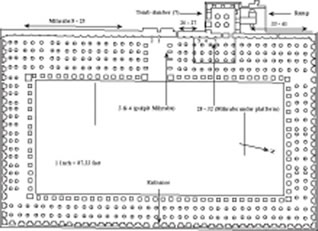
Another unusual feature in the Adina, repeated again in a number of mosques sponsored by sultans or high officials, is the takht or raised platform in the northwestern corner, which functioned as a maqsura (royal enclosure). This was screened off from the rest of the mosque; had a separate entrance in the northwest approached by a ramp from the outside, and could be used by the king and his entourage.
Each wing of the prayer chamber was organised along the same principles as the mosque in Tribeni; columns form numerous square bays, each one covered by a dome, and the qibla wall has a mihrab opposite every entrance in front, so that there is a staggering number of three hundred and six domes and forty one mihrab niches. The stone veneer has been re-used with a much better understanding than the helter-skelter manner in which plundered material was used in earlier mosques; mihrab interiors with hanging lamp motifs were carved specifically for the mosque. The terracotta motifs of the mihrab tympanums are noteworthy for their excellent craftsmanship. The tradition of carving had pre-Islamic precedents; the Buddhist/Hindu sculptor who made religious images of imported stone had enjoyed a higher status than makers of terracotta. With the advent of Islam, which did not make use of stone images, mosques were lavishly decorated in terracotta. By supporting terracotta, the Muslim rulers elevated the status of the terracotta artist. Some traces of coloured tiles and painted plaster remain. In the nave, to the north of the central mihrab, is a carved stone mimbar (pulpit from where the imam delivers his Friday sermon) approached by a staircase.
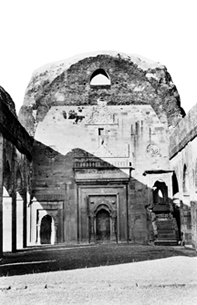
A typical Bengal style of architecture with salient features derived from the rural hut evolved in the 15th century; the eklakhi mausoleum in Hazrat Pandua, Maldah district, West Bengal, (fig. 4) being most significant in this development. It is believed to be the tomb of Sultan jalaluddin muhammad shah, the converted son of raja ganesha, and his family.
The first Muslim sultan of Bengali origin, he favored a style with indigenous roots. The tomb re-established brick alone as the primary building material, and its form, a single-domed square building with curved cornice and roof, squat hemispherical drumless dome, engaged corner towers, and terracotta ornamentation, influenced all subsequent buildings, particularly mosques, the only building type that has survived in large numbers.
The hut was the model for a type of pre-Islamic Buddhist/Hindu temple (bhadra), examples of which are found in Myanmar. Antecedents of these must have existed in Bengal, because from here ideas of religion and religious buildings spread further east. References to temples in manuscript paintings and stone sculpture also prove that ancient Buddhist /Hindu temples were small square structures ultimately based on the village hut. They had straight cornices, and roofs crowned with xikhara or stupa, the signifiers of function and denominational affiliation.

The Eklakhi and subsequent buildings differed in elevation because they always had curved cornices and roofs crowned with domes. They did not replicate the entire thatched roof because domes had the symbolic function to broadcast the presence of Islam in a largely non-Islamic environment. They imitate the curvature of thatched roofs of the rural chala huts of Bengal. These are generally single-roomed structures with a roof sloping down in two segments (do- chala) or four (chau- chala), away from the centre of the room. The top ridge where the segments meet, as well as the eaves on the lower edge, are curved because of the flexible nature of the bamboo frame that supports the thatch. The stocky, octagonal corner towers which emphasize the solidity of the Eklakhi may have been inspired by the corner posts of a hut, which bear its fabric but are usually hidden from view. Jalaluddin's seventeen-year reign heralded the beginning of an era when the sultanate firmly grounded itself in the culture of the land, and the style of the Eklakhi reflects the new outlook. Incorporation of hut forms into a brick medium became so popular that the style persisted even after the restoration of the old Iliyas Shahi house in 1435.
The Bengal style is well reflected in the architecture of the restored Iliyas Shahi (1433-1486) and husain shah (1494-1538) periods, much of which is located in Lakhnauti, later called gaur, the capital. The international border between India and Bangladesh runs through this ancient walled city, both parts are still known as Gaur. The buildings reflect the absence of any need for monumental symbols and fit in well with local culture, which even in pre-Islamic times lacked structures on a monumental scale, the Mainamati and Paharpur monasteries being rare exceptions. The sultans no longer had the air of foreign rulers whose buildings must symbolize political power or the majesty of religion. Mosques of modest size suggest that the Muslims had begun to feel accepted in Bengal.
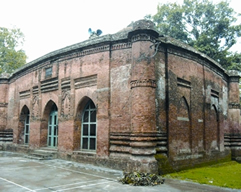
Instead of trying to impress people with imposing architecture, they concentrated on their own ritual needs by building small, practical mosques that fitted in with the local building tradition. Numerous small, square, single-domed mosques inspired by the Eklakhi tomb, and some medium sized, rectangular, hypostyle mosques with multiple bays and domes are extant from this time onwards.
A good example of the 15th century style is the mosque in Rampal (Munshiganj district, Bangladesh), dated 888 AH (1483). It is named after Baba Adam Shahid, traditionally known to be an early martyr of Islam, whose tomb is nearby. It is a medium-sized, rectangular, hypostyle mosque with three bays and two aisles covered by six domes (fig.5). Decoration during this century was subordinated to the building design, so that there is no excess of ornamentation. Large decorated panels stand out in high relief against plain walls, as in the Eklakhi Mausoleum. A thin layer of lime wash, once probably painted, is sometimes still visible on the surface of the terracotta plaques.
Sometimes a verandah would be added to the front, just as in a residential hut, with additional engaged towers in the exterior where the verandah joined the prayer chamber. Examples of small and large mosques with verandahs are the gopalganj mosque in Dinajpur dated 865 AH (1460), where the prayer chamber is only 4 metre square; and the darasbari mosque in Gaur dated 884 AH (1479) with a 30.32 metre ' 11.8l metre rectangular prayer chamber, both in Bangladesh (fig.6 and7). The verandahs used a variety of roofing devices: cross-vaults, as in the Gopalganj Mosque; or domes; or combinations, as in the Darasbari Mosque. Built by Sultan Yusuf Shah in 884 AH the latter once had a maqsura in the northwest corner approached by a flight of steps outside the north wall. The terracotta decoration that fills the tympana of the mihrabs in the interior is remarkable for its liveliness and deep relief.
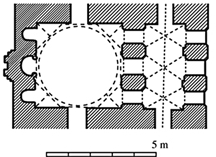
Deviations within the style prove the dynamism of 15th century architecture. From the middle of this century there is a homogenous group of monuments in southern Bengal known after khan jahan. His title ‘Ulugh Khan-I-Azam’ suggests that he was an ethnic Turk and a high ranking officer in the Bengal Sultanate. He is popularly credited with Islamising and clearing forests in the area that now comprises the Bagerhat, Khulna, Jhenaidah, Jessore, and Patuakhali districts of Bangladesh. He is said to have founded khalifatabad, with its administrative centre of Haveli Khalifatabad, presently identified with Bagerhat. The majority of the Khan Jahan style mosques are located in this area.
They range from very large to small in size, and include an unusual square, nine-domed type. Although rooted in the 15th century architectural tradition of Bengal, their stark, unadorned exteriors, circular engaged corner towers, and massive appearance show considerable influence from Tughluq architecture of Delhi. The most important example of this group is the shatgumbad mosque in Bagerhat, the largest mosque in Bangladesh (fig. 8). The mosque has eleven bays and seven aisles, with the largest bay in the centre. This central bay is divided into seven independent, rectangular bays that are covered by the chau'-chalas; this being the earliest use of the form in Bengal. It connects the largest entrance in the east to the largest mihrab, and divides the mosque into northern and southern wings.
The interiors of the miniature chau-chalas have thin, raised bands of brick that imitate the rafters and purlins of bamboo hut frames. The rest of the bays also terminate in mihrabs except the one immediately north of the central mihrab, which has an entrance doorway reserved for the imam so that he can enter directly from behind the mosque.

There are seven entrances each on the north and south sides. It seems that the stone pillars once had brick casings, because there are traces of brickwork around some of their bases. The bare exterior walls are articulated by recesses. The curved cornice comes to a point over the central arched doorway in the east, resulting in a triangular shaped pediment, which is probably derived from the gable ends of do-chala huts. The four circular tapering corner towers are domed, and the two in front have staircases inside, making these the only ascendable towers attached to a mosque in this period. The monumental gateway in the east indicates that there was probably once an enclosing wall around the mosque.
Besides the tomb in Bagerhat the only other dated monument in the Khan Jahan group is the masjidbari mosque of 876 AH (1471-72 AD) in Mirzaganj, Patuakhali district. This mosque not only indicates the extent of influence of the Khan Jahan Style, but also helps us map the southern limits of Sultan Barbak Shah’s kingdom to whose reign it is dated. It is also the only extant mosque with a large chau -chala vault covering the entire verandah. The interior of the vault shows how meticulously the terracotta decoration was used to simulate the patterns of woven bamboo strips (fig. 9)
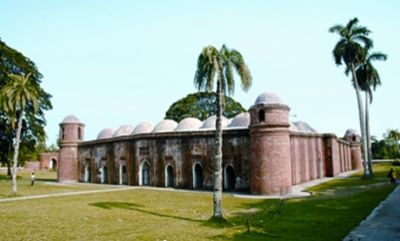
Three of the four nine-domed mosques in Bangladesh, the nine-domed mosque in Bagerhat, the masjidkur mosque in Khulna, and the qasba mosque in Barisal are in the Khan Jahan style; the satoir mosque in Faridpur, being of a slightly later date. Fairly large in size, in plan and elevation they are enlargements of the square, single-domed type of mosque. A typical one is the Masjidkur Mosque in Khulna where the interior is about 12.19 metres square and the walls are 2.20 metres thick (fig. 10).
Four pillars in the centre divide the interior into nine equal square bays, each one covered by a dome. There are three entrances on each of the east, north and south sides. According to convention, the three mihrabs in the west wall are on axis with the front entrances. The only earlier building of this plan is the chamber attached to the west wall of the Adina Mosque in Hazrat Pandua, popularly believed to be the tomb of Sultan Sikandar Shah, the patron of the Adina.

There are no pre-Islamic examples of nine-bayed buildings in Bengal, but such mosques are known, though not common, throughout the Islamic world; they are rare in other parts of India. In Bengal they were discontinued after the Sultanate period, but there are nine-bayed tombs in later Mughal times throughout the subcontinent. The building type, perhaps imported from the central Islamic lands, became popular because it was entirely covered, and thus met the need for sheltered space for assembly in Bengal. In usage it became thoroughly Bengalised, and gives the impression of a large square building where the single-domed square unit has been multiplied. A nine-domed building was the only solution if a symmetrical enlargement of the popular square, single-domed mosque was desired, while still retaining the emphasised central mihrab. Compared to the smallness of the single-domed mosques, these were large and most certainly built for the Friday congregation.

Sultanate architecture of the 16th century includes buildings of the Husain Shahi (1494-1538), Suri (1538-63) and Karrani periods (1563-1575), before the takeover by the Mughals in 1576. The general peace and prosperity brought about by the Husain Shahi rulers resulted in a large number of buildings of a rather uniform style. Although the Bengal style spread as far as Bihar and Assam at this time, there was nothing outstanding or innovative in design. Craftsmen seemed to occupy themselves with refining decoration and details.

There are several mosques both in West Bengal and Bangladesh that represent this late Sultanate style. Tiles, which had appeared in a restrained manner in the 14th (Adina Mosque) and 15th (Khan Jahan's Tomb) centuries, are now in profusion as in the lattan mosque in Gaur, West Bengal. Stone is also sometimes used to encase brick, as in the Bara Sona and Chhota Sona mosques in Gaur, (West Bengal, and Bangladesh), Sura and the Kusumba mosques in Dinajpur and Raishahi, Bangladesh.
The Chhota Sona Mosque in Gaur (fig. 11) dates by inscription to the reign of Sultan Alauddin Husain Shah (1494-1519), and was built by one Wali Muhammad, a high official in the royal court. This rectangular mosque is completely faced with stone in the exterior, while inside there is stone up to the springing of the arches. Pillars, pilasters, and the maqsura platform in the northwest corner are of stone. cunningham also reports seeing screens of trelliswork, now disappeared, which used to partition off the platform, entrance to which was from the exterior northwest side. In this five-bayed mosque the central bay is wider than the others and has chau-chala vaults instead of domes, as in the earlier Shatgumbad and Darasbari mosques.

There is abundant stone carving in low relief in the exterior, and ornamental niches within rectangular panels, rosette and kalasa (pot) motifs that are used repeatedly. There are similar motifs in the mihrabs inside, but the central mihrab is bare and the stone structure is now believed to be in the Royal Scottish Museum in Edinburgh.
The bagha mosque in Rajshahi (fig. 12) was built by Sultan nusrat shah (1519-32), son of Husain Shah in 930 AH (1523-24). This rectangular mosque is within an enclosed courtyard, to be entered by a gate. Four pillars in the north-south direction divide the interior space into two aisles and five bays, each of the resulting ten bays being covered by a dome. The presence of a mihrab on an upper level in the northwestern bay indicates there was a maqsura platform in that corner that must have been approached by a flight of stairs in the east, although no trace of platform or staircase exists.

It is also possible that a platform was planned but never built. The mosque is profusely decorated with terracotta, and the style is so distinctive that several monuments are dated stylistically to the early 16th century on the basis of similarity to the 'Bagha style'. Rectangular panels with cusped arches and hanging motifs are predominant in the decorative scheme (fig. 13).
The hanging ornament has lost its earlier vegetal quality and become highly ornamental, approximating jewelry design. The rectangular frames of the three large mihrabs in the interior have panels with niches holding flowering rose, fruiting pomegranate and mango trees.
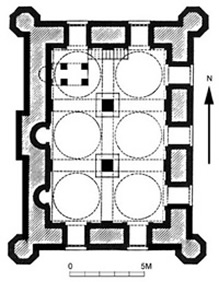
The Mosque at Kusumba, Rajshahi, dated by inscription to 966 AH (1558-59), is a rectangular six-domed mosque of two aisles and three bays whose exterior is entirely faced with stone (fig. 14). It is one of the last major monuments of the Sultanate period, and recalls plans of the earlier mosque of Muazzampur of 1435-36 and Baba Adam’s Mosque at Rampal of 1483 in Bangladesh. It also anticipates the single-aisled, three-bayed plans of the end of the 16th century.
The stone-faced interior and exterior, curved cornice, engaged corner turrets, and the maqsura platform in the northwest corner belong to the tradition of the Chhoto Sona Mosque.
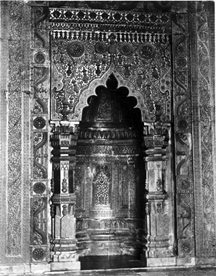
The platforms of these two non-imperial mosques prove that they were used not only by the king, but others of high position to separate themselves from the masses during prayer. All the decoration is on carved stone, and on the exterior a prominent moulding divides the wall into upper and lower sections. The outside stone facing is coarse and the carving is in shallow relief. Inside, the mihrabs and the platform supports are very elaborately carved. There are bunches of grapes, serpentine vines, and kalasas; tendrils and rosettes are reduced to dots (fig. 15). Although akbar conquered Bengal in 1576, it was many decades before the resistance of powerful local landlords could be crushed, and it was only in 1613 that the whole of Bengal was firmly integrated into the Mughal empire. Two mosques in Bangladesh built by the Qaqshals, one of the rebel Afghan clans, occupy key positions in the transformation of the Sultanate style to Mughal.
[Image:KheruaMosquePlan.jpg|thumb|400px|left|Fig. 16: Kherua Mosque plan]] These are the chatmohar mosque, Pabna, dated 989 AH (1581-82), and the Kherua mosque in Sherpur (fig. 16) dated 989 AH (1582). These mosques used the single-aisled, three-bayed plan, which was to become the plan par excellence for Mughal mosques in Bengal from the 17th century onwards. In elevation the octagonal corner towers, the curved cornice, low drumless domes, brick surface and pointed arches link them to the Sultanate style.
In contrast to the buildings of the Sultanate period, which have a marked regional character, Mughal buildings are constructed within the imperial tradition of Delhi and Agra, but are more subdued than contemporary architecture elsewhere in the subcontinent. As in Sultanate times, Mughal mosques consist of only a prayer hall, which is now single-aisled with three or five bays. The exterior surfaces are plastered and paneled, the cornices are straight, and the buildings look less ponderous than Sultanate ones because of the higher domes.

A refined Mughal provincial style was developed in the capital city of Dhaka in the 17th century. The Lalbagh Fort Mosque in Dhaka dated 1059 AH (1649) and 1194 AH (1780) conforms to the typical Mughal mosque plan. Located inside the fort, closest to the river, it was probably the earliest building on the site (fig. 17).
Lateral arches in the interior divide the rectangular structure into three bays, the central one being the largest. The building is plastered, and the entire east facade is divided into small rectangular panels; the engaged tapering corner turrets have regularly spaced horizontal mouldings. The three doors in front are placed within recessed arches with half-domes ornamented with faceted stucco motifs. The straight cornice is embellished with a row of merlons; its height varies, the central section, which corresponds to the largest bay, being the highest. Inside, the north and south walls have panels like the exterior, and the stucco motifs of the entrances are repeated in the three mihrabs.
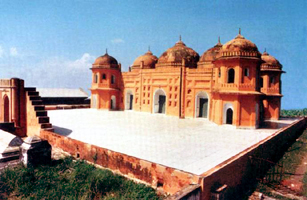
The 1780 date, now whitewashed, must refer to the restoration of the mosque when the domes were reconstructed, because fluted domes such as these, especially like the side ones which have a restricted shape, are more common in the late 18th century architecture of Murshidabad. The domes, placed over drums, are higher than their Sultanate counterparts.
The satgumbad mosque in Dhaka, also of the second half of the 17th century, has a unique character (fig. 18). Although the main prayer chamber has the regular three-bayed plan, enormous double-storied, domed corner pavilions replace the usual engaged turrets. The three domes of the prayer chamber together with the four corner ones add up to a total of seven, thus giving the mosque its name.
While mosques in Dhaka reflect the imperial style of Delhi, the Sultanate style lived on in several mosques that were built away from the capital. The atiya mosque in Tangail district in Bangladesh was built in 1018 AH (1609) by Sayyid Khan Panni. It is a single-domed, square mosque with a three-domed verandah in front, engaged octagonal corner towers and curved cornice.
Its weightiness, suggested by the relatively small entrance arches as well as the ornamental style of the exterior surface which is broken up into numerous small niches (fig. 19), recalls Sultanate monuments, eg the kadam rasul (1530) and jahaniyan mosque (1535) of Gaur, West Bengal.
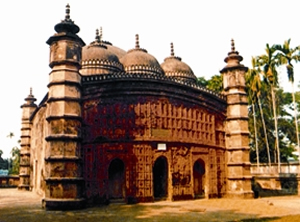
But the drums of the domes, the lotus finials, and the merlon decoration are Mughal. sadi mosque in Egarasindur, Bangladesh dated 1062 AH (1652) is another mosque that harks back to Sultanate times.
Two mosques in Dhaka dating from the early 18th century mark the termination of the high tradition of Mughal architecture which had begun a hundred years earlier.
These are kartalab khan’s mosque in Begumbazar, which he reportedly built during his residence in Dhaka between 1700-1703, and Khan Muhammad Mridha’s Mosque in Lalbagh dated by inscription to 1116 AH (1704-05). Both are built on raised terraces with vaulted rooms in the plinth that were used for shops or for madrasa students. Both are single-aisled, and while Mridha’s Mosque has three bays, Kartalab Khan’s has five. An unusual feature of Kartalab Khan’s Mosque is the room with a pitched do-chala roof with drooping eaves that is attached to the north side of the mosque (fig. 20)

By 1717 murshidabad became the last Mughal capital of Bengal. The earliest surviving and most significant of the monuments that were built to embellish this capital is the Jami Mosque, also known as the katra mosque, built 1137 AH \1724-25 (fig. 21). The name comes from the domed chambers that surround the mosque on all four sides, which are locally known to have served as a market but have been described also as a madrasa. In accordance to his wishes, murshid quli khan was buried under the entrance to this mosque.

The largest Mughal mosque in Bengal, the Katra Mosque is now ruined. This single-aisled, five-bayed mosque sits on a high plinth about 54 metres square. Although the plan is typically Mughal, its massiveness, and the ornamental style of its exterior surface, like the Atiya recalls the Jahaniyan Mosque of Gaur of Sultanate times, and contrasts with the elegant Mughal buildings in Dhaka. The rounded shape of the cusped arches may indicate an early European influence, and the harking back to the Sultanate style symbolizes the break with Delhi just as quarrels among the successors of aurangzeb was leading to the decline of Mughal power there. [Perween Hasan]
Bibliography Alexander Cunningham, Report of a Tour in Bihar and Bengal in 1879-80, The Archaeological Survey of India Report, XV, Calcutta, 1882; A H Dani, Muslim Architecture in Bengal, Dacca, 1961; S M Hasan, Mosque Architecture of Pre-Mughal Bengal, (2nd ed), Dacca, 1979; George Michell (ed), The Islamic Heritage of Bengal. Unesco, Paris,1984; Perween Hasan, Art and Architecture, in Sirajul Islam (ed), History of Bangladesh 1704-1971, 2nd ed, Dhaka, 1997.
